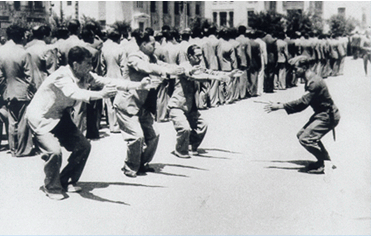
Στις 15 Μαρτίου 1943,
οι πρώτοι Εβραίοι της Θεσσαλονίκης,
αναχώρησαν για τα στρατόπεδα συγκέντρωσης
50.000 από αυτούς, δεν επέστρεψαν ποτέ.
Έγιναν “τροφή” για τη κρεματόρια των ναζί.
Στις 14 Μαρτίου 2013, οι απόγονοι των ναζί στην Ελλάδα,
πρότειναν ένα ακόμα μέτρο, στα βήματα των προγονών τους:
Διαχωρισμός στα σχολεία για τα παιδιά των Ελλήνων και των μεταναστών.
Τα πράγματα αρχίζουν να μοιάζουν όλο και πιο έντονα,
με την εποχή του ’43 και τις μεθόδους του Χίτλερ.
Οι σειρήνες των τρένων του θανάτου, ηχούν ήδη κοντά μας.
Η ιστορία, αρχίζει να ξεπροβάλει μέσα από το πιο σκοτεινό θάλαμο της μνήμης μας.
από : http://correspondent4.wordpress.com
------------------------------------------------------------------------------ >
 |
The
declining Jewish population in Greece in 1941 probably did not exceed
the 67,200 of the 1931 census. In 1945 the officially registered
survivors numbered rather more than 10,000
If
the Germans believed in March 1943 that they were saving Greece from
Jewish strangulation, they could have spared themselves the trouble, for
this was a fast-dying community.
Two-
thirds of Greek Jewry lived in Salonika, the only Spanish Jewish
settlement of Turkish times to prosper and expand since the creation of
the Greek kingdom. Yet, in the twentieth century, the Salonika Jews
declined.
In 1900 when they numbered 80,000 they constituted nearly half the cities population.
On
9 April 1941, Salonika, on the eve of the German occupation had
probably 260,000 inhabitants only 46,000 of them Jews. Emigration had
been forced by poverty and also by a certain degree of anti-Semitism,
which became stronger after the expulsion of the Turkish population In
1923-24.
But
Salonika was not a place where the Germans could count on the native
population doing their work for them. This is shown by the fact that
they hesitated to apply the Final Solution till a year after the first
murderous Jewish deportation trains had left France and Slovakia.
Apart
from the usual arrests of Jewish notables and the conversion of the
Jewish Community Council into something resembling a German –appointed Judenrat, there were no specific anti-Jewish decrees till July 1942
Yet,
in the winter of 1941 the Salonika Jews were scarcely better off than
their brethren in the starving ghettos of Poland. The invasion had
deprived Greece of her normal produce exchange of dried fruits, tobacco,
and olive oil against wheat.
In
November famine was already in sight. Although in March 1942 the
British Government sent some wheat shipments – under safe conduct from
the enemy- to Athens, 20,000 of the Salonika Jews starved and there was
an outbreak of spotted typhus.
This
situation did not prevent the German administration office of the
“Salonika – Agais Command” decreeing in the month of July heavy labour
conscription for all Jewish males from eighteen to forty-five years old.
But the Todt Organisation had difficulty in finding three or four
thousand men for railway construction among this debilitated mass of
people.
Consequently,
in October, exemptions were freely sold, and finally Dr Alfred Merten,
counsellor to the Military Administration, stopped the conscription on
payment of a community fine of 2,500,000 drachmas.
The
Germans began the Final Solution in Salonika, as they had begun it in
Poland, by destroying the vestiges of Jewish history, the archives and
liturgic scrolls, and finally the grave-stones. These were removed for
road-metal from the great Salonika cemetery on 6 December 1942, when SS- Sturmbannfuhrer Wulff of Eichmann’s office was making a preliminary survey.
Shortly
afterwards Eichmann was said to have paid a brief visit, bringing his
adjutant Rolf Gunther. The deportations were to be carried out by Dieter
Wisliceny, who arrived from Vienna with Anton Brunner on 6 February
1943.
ΕΔΩ :www.holocaustresearchproject.org

Δεν υπάρχουν σχόλια:
Δημοσίευση σχολίου